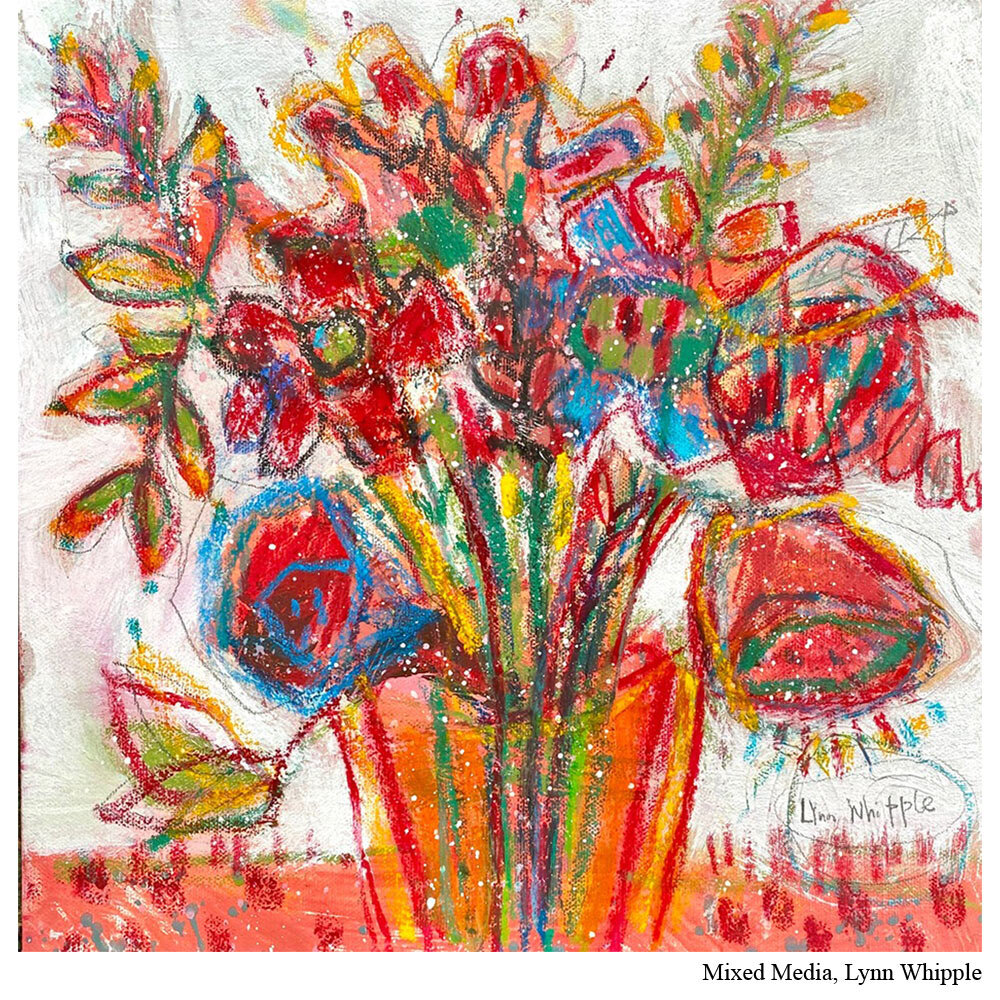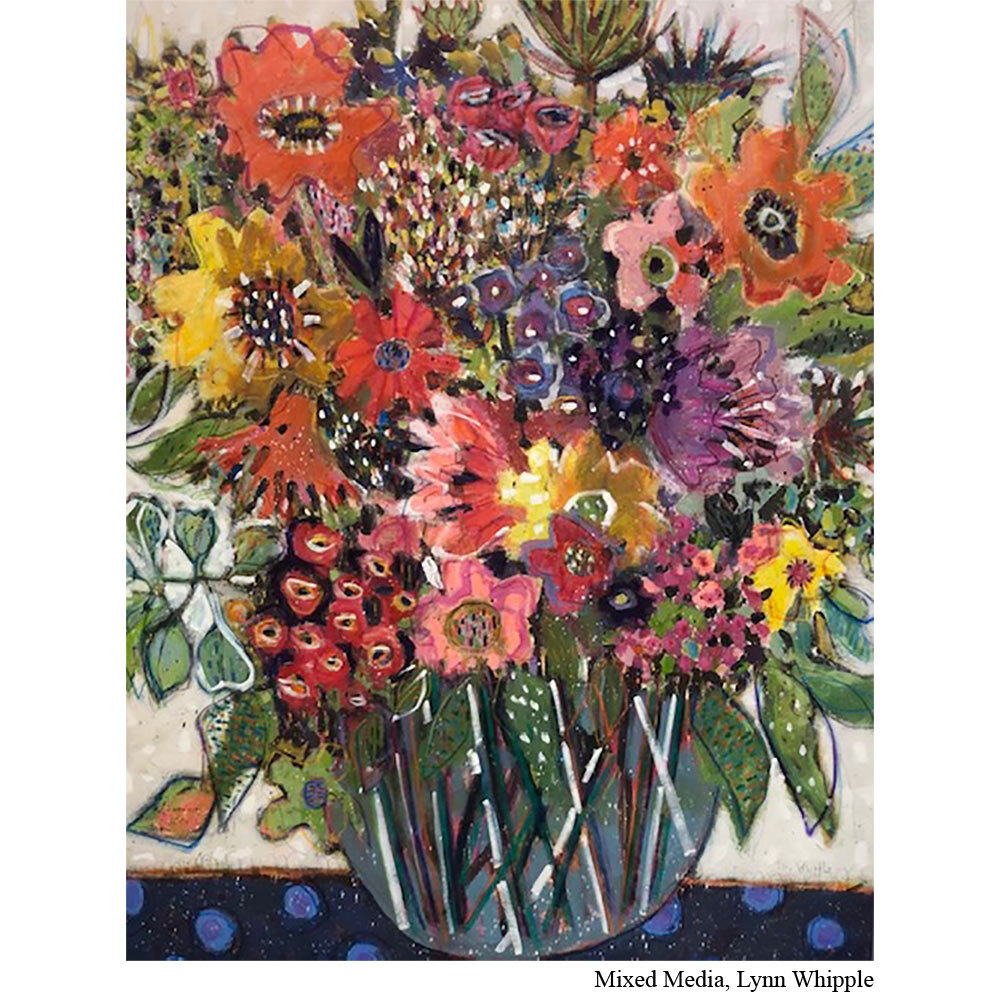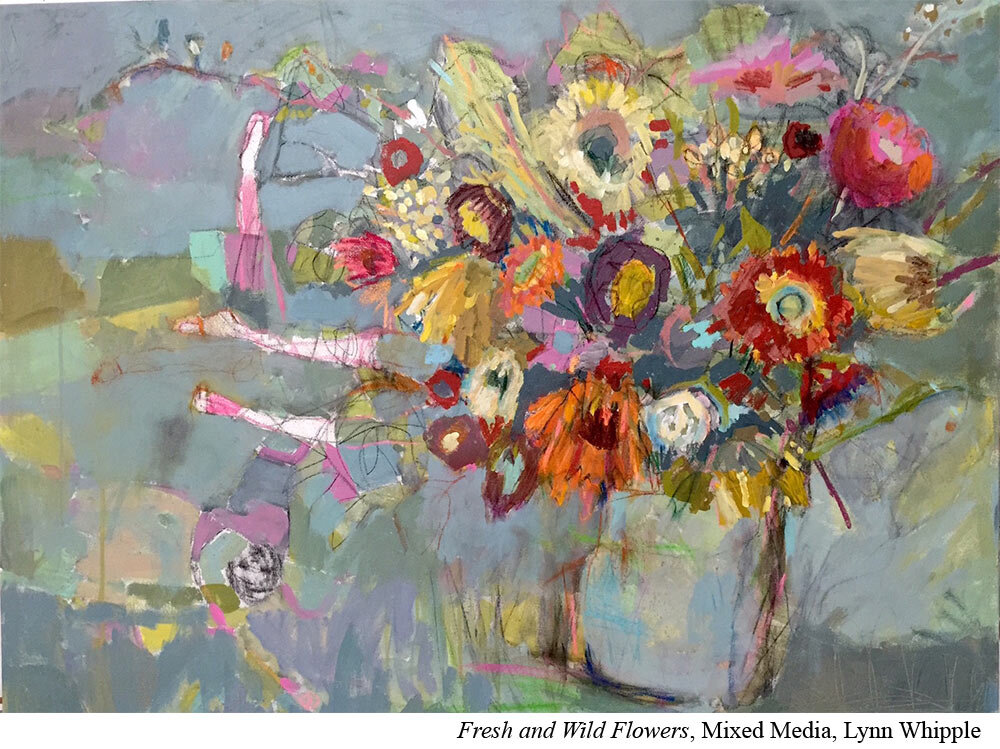Fully Committed to Play: How Lynn Whipple Paints a Painting
Artist Lynn Whipple isn’t into drudgery. When things get too tight, she heads into her backyard with her dog Daisy and they jump on a mini trampoline to get it all out. She turns on music. She dances. She fills her home studio with things that delight her, from flowers to string and piles of paint. She wants her work - and her experience working- to be joyful.
And it’s not without reason.
“I think my whole silly process is how can I be in the moment,” says Whipple. “How can I just have fun and play and just react.”
SKETCHBOOK BORN
Whipple’s process begins in her sketchbooks. This is her introduction to her subject matter. It’s an initial conversation between artist and flowers, which she’ll have several bouquets around her studio.
“Any time you can spend looking at your subject and translating it down into your marks, your shapes, is always valuable,” says Whipple. “So I try not to skip it.”
Often Whipple will have an idea about the canvases she plans to use. She then heads to her sketchbook, draws a bunch of squares or rectangles (vertical or horizontal) based on that choice. She then begins exploring possible compositions and value patterns.
If the drawing will expand beyond it. No problem. She just redraws the square larger to fit the new drawing.
“I think my whole silly process is how can I be in the moment,” says Whipple. “How can I just have fun and play and just react.”
She’s always expanding to meet her idea instead of trying to trap it down in a preconceived idea or space.
“You can just learn so much with your Sharpie and a piece of paper.“
HEADING TO CANVAS
Once Whipple knows the format she’ll paint in (square, horizontal rectangle or vertical rectangle), it’s time to pull out her substrates.
For drying time purposes, Whipple works across several canvases at a time. Another reason: preciousness.
This comes up again and again when looking at Whipple’s process. She wants to stay loose and have fun. To do this she actively avoids preciousness through a number of ways. She makes sure she has enough materials so that she won’t get precious about paint. She works fast so she doesn’t let herself get precious about the decisions she’s making (although she does slow down at the end of her process.) She has systems in place that work for the artist and surround her with abundance.
This in turn gives her the freedom to make changes and take risks. It gives her the freedom to have fun.
It’s in part why she begins in her sketchbook. She can make as many changes in her sketchbook as she wants. She has freedom there. Abundance of opportunities.
UNDERPAINTING
Next comes the big, loose underpainting. Whipple uses this step to warm up and start the first few layers in an interesting way.
“I'll usually do one ….really loose, drippy,” says Whipple. “I don't cover everything. I want it to breathe. I want it to spatter. I just want it to be this big messy thing because it's just an underpainting.”
If she starts a warm underpainting, she’ll also start a second one with its opposite. For example, if she begins one with orange, she’d begin a second canvas with a greyed down blue (orange’s complement).
“Any time you can spend looking at your subject and translating it down into your marks, your shapes, is always valuable.”
-Lynn Whipple
“[When] that's all dry… if I have an orange canvas, just to juice it up, I'll take some of that blue gray and spatter on that. So right away, I've got a little bit of zing from the warm in the cool on the canvas.“
The underpainting begins to have sparkle right away. It’s also a way for Whipple to comfortably enter the painting space. Approaching a canvas, especially a big one, can be a scary task.
“Sometimes there's that inertia,” says Whipple. “You know where you can't get started and...oh, everything's fighting me. [But] if I know that what I do is lay out six canvases and just slap down my first layer. I think that helps.”
DRAW DRAW DRAW (But really LOOK LOOK LOOK)
Next comes drawing.
“Drawing is difficult,” says Whipple, “so let's just make it fun.”
She knows many people rush through drawing for that very reason. Realism is not Whipple’s first goal with drawing. But drawing is important because it’s how Whipple really begins to see what’s happening in the flowers.
In order to not get too tight and precious with her drawings, she’s come up with an approach for both herself and her students.
It’s all about the spin.
Looking at her flowers, Whipple will draw them onto her substrate. Sometimes one handed. Sometimes opposite handed. Sometimes with both hands holding opposite colors. Often it’s with charcoal. She draws in her flower shapes and then wipes them out. She then spins her canvas.
Draw them in. Wipe them out. Spin.
“Drawing is difficult,” says Whipple, “so let's just make it fun.”
She’ll do this several times until she’s left with layers of under drawings all peeking through.
On this she draws her final flower drawing. And by this time, it isn’t scary.
She has spent this whole time really looking at her flowers. Getting to know her subject matter. Practicing the movements of translating the 3d world onto a 2d canvas. Plus she has created some amazing shapes that she will use later. And most importantly, she loves doing it.
CREATING ABSTRACTION
It’s almost painting time, but before she grabs any colors, she draws straight lines through her work. This creates variety by adding straight lines into a canvas that’s filled with organic lines.
Next it’s to the paint. Working with the complementary color of the underpainting, Whipple begins to paint in those abstracted shapes she’s built up through the underdrawings.
“You end up with this crazy underpainting that you could never come up with in 1000 years,” says Whipple, “[and] the whole time you're playing with color. You're looking at the flowers. You're drawing. And you've got freedom. So it just sets you up for the real flower painting on top.”
THE PAINTING ON TOP
“So once I know that I have this loose drawing, then I just start putting in the color,“ she says
Whipple works back and forth between lights, mediums and darks. But at some point she stops and really considers her darks.
“There's always a point...when I stop, and I mix some really interesting darks. I don't just use black. I want it to have color and be rich and interesting. And then I purposely stop and put in the darks. I just feel like I have to take time to squint down and just see where those darks are.”
“I think that the paintings talk to you,” says Whipple. “I think you're in a dialogue with them all the time. Sometimes you have to be quiet so you can hear or you can see what's missing.”
The darks don’t always completely line up.
“It might just be a weird squish there and a strange line there and a gush over there and a little underneath a petal shape. I mean, it's very, very abstract. But there's a true structure that happens because I'm really looking at it.”
Once she has has the darks in, the dance begins again. She may look next for her lightest lights.
“It's a game. Back and forth, back and forth.”
GETTING QUIET
Whipple wants her work to have the energy of fast painting but her process isn’t all fast and it certainly isn’t mindless.
She does a great deal of thinking at each stage in her process and there are places where the dancing stops, the music turns off, and she stands quietly before a painting asking what it needs.
“I think that the paintings talk to you,” says Whipple. “I think you're in a dialogue with them all the time. Sometimes you have to be quiet so you can hear or you can see what's missing.”
She also gets some distance both in time and space.
“I like to get pretty far across the room,” she says. “When I'm not sure about a painting, I'll set aside overnight.”
“People almost always are like shocked that it all comes together when you simplify the background.”
She also uses surprise as a way to see something she’s been missing.
“I'll walk away, maybe for hours,” she says. “And then I'll come back, and I'll sneak up on it...I'll pop my head in the door and I'm like, Okay, what does it really look like now?”
This time away gives her a new perspective.
“I've almost looked at it too long that I don't see it. And then all of a sudden, something obvious will pop out. And I'll [realize] clearly that it needs this.”
THE FINAL TOUCHES
Once the flowers are how Whipple wants, it’s time to add the background.
“It's almost magical when you choose a background color, and then you can sort of cut in.”
She takes her background color and paints around the big shapes of the vase, the table plain and her flowers.
“People almost always are like shocked that it all comes together when you simplify the background.”
This cutting in allows her composition to really show.
Next, it’s line.
“The drawing is fun because it's fluid. It's fast. It's mark making. It's energy.”
Whipple uses first pastel and then graphite. She doesn’t necessarily trace her shapes but draws beyond them first in pastel and then on top with graphite pencil.
“You overlap a line that doesn't match up with that shape and it's the opposite color perhaps or you start to describe a little spot inside of the flower. You just start to put in your details. It's your hand. It's your mark”
A JOYFUL PROCESS
Whipple’s process has everything. It has drippy. It has thick. It has light and it has dark. Big shapes and tiny lines. The artist wants people to stop and look and realize just how much there is going on. That there is a delight that pulls the viewer forward to look closer at her work.
“It's like a poem,” says Whipple of her finished paintings, “that's loud but yet super soft.”
And I’d add, a joyful poem for artists, students and spectators alike.







